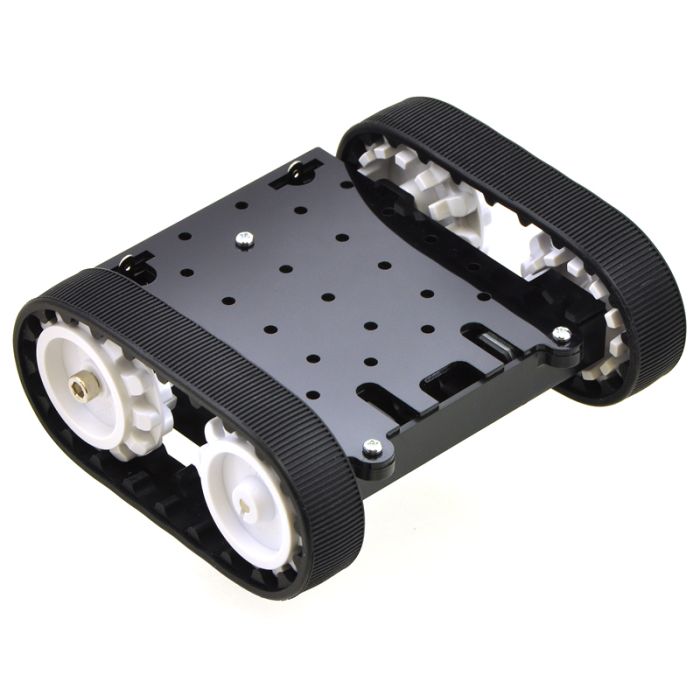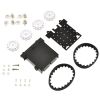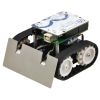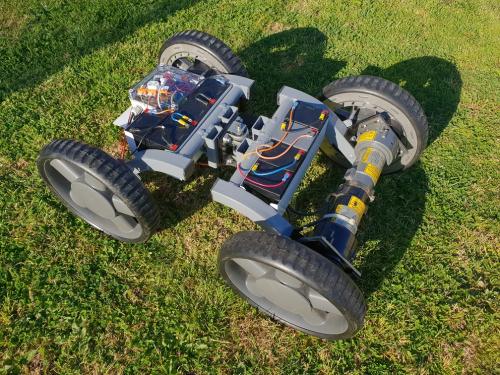Zumo Chassis Kit (No Motors)
Available with a lead time
Expect dispatch between Dec 26 and Dec 29
Quantity Discounts:
- 10+ $35.69 (exc GST)
- 25+ $34.58 (exc GST)
The Zumo chassis kit contains the components necessary to build a small, high-performance tracked robot platform that is compact enough to qualify for Mini Sumo competitions. The chassis is made from black ABS plastic and has sockets for two micro metal gearmotors and a compartment for four AA batteries (motors and batteries are not included). The battery compartment terminals protrude through the chassis and can be accessed from the top side. A black acrylic plate is included with the chassis. This plate holds the motors in place and can be used for mounting your electronics, such as your microcontroller, motor drivers, and sensors.
 |
|
Pololu Zumo chassis kit components. |
|---|
The drive system consists of two black silicone tracks, one on each side, that are each supported by a freely spinning idler sprocket and a motor-driven drive sprocket (see the Motors section below for more information on how to select appropriate motors for your robot). These tracks are also available separately in two different lengths and three different sprocket colors.
Assembly instructions are available in the user’s guide under the resources tab.
As of July 2015, this kit is shipping with black, spoked sprockets (see the main product picture and the kit component picture above). Some of the other pictures on this page still show the original white sprockets.
Motors (not included)
 |
|
Micro metal gearmotor with brass gearbox plates. |
|---|
 |
The Zumo chassis uses two motors, one for each tread. The ideal motors for your robot depend on your desired torque, speed, and current draw, so motors are not included with the chassis. Pololu generally recommend using high-power (HP or HPCB, which have long-life carbon brushes) versions of Pololu's micro metal gearmotors since the tracks require a decent amount of torque to move effectively; higher gear ratios of the non-HP motors might work if you want lower current draw, but they will be slower and offer less control. Specifically, Pololu primarily recommend the 50:1, 75:1, or 100:1 HP or HPCB motors for use with this chassis. The following table summarizes the key specifications of these three gearmotors. The first four columns are specifications of the motors themselves, while the last column is the measured top speed of a Zumo chassis loaded to a weight of 500 g and driven with these motors. Note that the specifications are for 6V operation, which is approximately the voltage you would get with four alkaline batteries; four NiMH AA cells will typically provide less than 5V.
| Micro Metal Gearmotor |
Free-Run Speed @ 6V |
Stall Torque @ 6V |
Stall Current @ 6V |
Top Zumo Speed @ 6V and 500g |
|
|---|---|---|---|---|---|
| 100:1 HP or 100:1 HPCB | 320 RPM | 30 oz·in | 1600 mA | 20 in/s | (50 cm/s) |
| 75:1 HP or 75:1 HPCB | 400 RPM | 22 oz·in | 1600 mA | 25 in/s | (65 cm/s) |
| 50:1 HP or 50:1 HPCB | 625 RPM | 15 oz·in | 1600 mA | 40 in/s | (100 cm/s) |
Electronics (not included)
You can add your own motor drivers, sensors, and programmable controllers to this chassis, or you can get one of Pololu's more complete Zumo robots, which include electronics designed specifically for the Zumo chassis.
 |
|
A Zumo 32U4 robot (left) and a Zumo robot for Arduino with an A-Star 32U4 Prime LV (right). |
|---|
The Zumo Robot for Arduino combines a Zumo chassis with a Zumo shield, which includes a dual motor driver, buzzer, and three-axis accelerometer and compass, giving you all the basic mechanical parts and electronics to build an Arduino-controllable robot (Arduino not included). The newer Zumo 32U4 Robot is a more highly integrated robot also based on the Zumo chassis that includes an Arduino-compatible ATmega32U4 microcontroller and even more sensors (quadrature encoders and a proximity sensor system).
If your goal is to make a robot based around a controller other than an Arduino, Pololu recommend the DRV8833 motor driver carrier or qik 2s9v1 for use with this chassis.
 |
Batteries (not included)
This chassis works with four AA batteries. Pololu recommend using rechargeable AA NiMH cells, which results in a nominal voltage of 4.8 V (1.2 V per cell). When the batteries are fully charged, they will be well above 5 V, and when they are almost spent, they will be well below 5 V. As such, you might consider using a step-up/step-down voltage regulator to power your logic, since this will hold your logic voltage steady at 5 V, no matter if your battery voltage is above or below 5 V. You can also use alkaline cells, which would nominally give you 6V, but that voltage would drop depending on the load.
Basic sumo blade (not included)
Pololu carry a basic stainless steel sumo blade that can be mounted to front of the Zumo chassis. With this blade, the Zumo chassis can push around objects, such as other MiniSumo robots. You can also use the design file for this basic blade as the starting point for a custom sumo blade.
 |
|
Basic sumo blade mounted on a Zumo chassis. |
|---|
Replacement sprockets
The Zumo chassis includes the black sprockets shown in the left picture below, but Pololu also have sprockets available in in red and white that can be purchased separately if you want to add a bit of personalization to your chassis. Note that the white sprockets are white versions of the new, spoked style, not the older style still visible in some of the other pictures on this page that show white sprockets.
|
|
|
Dimensions
Fully assembled, the Zumo chassis is 98 mm wide, 86 mm long, and 39 mm high, with approximately 5 mm of ground clearance.
|
|
Since each side is smaller than 10 cm, this chassis meets Mini-Sumo size requirements. The front screws used to mount the acrylic plate to the chassis can also be used to mount a front scoop that can extend up to 14 mm before exceeding the Mini Sumo limits. The assembled Zumo chassis weighs approximately 210 g with motors and batteries.
 |
|
Example robot based on the Pololu Zumo chassis next to a Parallax SumoBot. |
|---|
People often buy this product together with:
 |
50:1 Micro Metal Gearmotor HP 6V |
 |
100:1 Micro Metal Gearmotor HP 6V |
 |
Basic Sumo Blade for Zumo Chassis |
Dimensions
| Size: | 98 × 86 × 39 mm |
|---|---|
| Weight: | 7.5 oz1 |
Notes:
- 1
- With motors and batteries; weighs 3.0 oz as shipped, without motors or batteries.
Documentation and other information
-
Pololu Zumo Chassis User’s Guide (Printable PDF)
User’s guide for the Pololu Zumo chassis.
File downloads
-
Zumo chassis acrylic mounting plate design file (10k dxf)
-
3D model of the assembled Zumo Chassis Kit (19MB step)
Note: this model includes micro metal gearmotors that are sold separately from the Zumo Chassis Kit.
Recommended links
-
PiBot-B: mobile robot with a Raspberry Pi
This robot uses a Raspberry Pi and Zumo Chassis Kit and can be remotely controlled over WiFi from an iPhone. The page is written in German, but it has a link at the top to translate it into English using Google Translate. Pololu also wrote about the PiBot-B in Pololu's blog.
-
This article was written by Professor Erich Styger for his class on embedded systems programming at the Lucerne University of Applied Sciences and Arts. It describes various ways to tweak the performance of a Zumo to be more competitive in a Mini Sumo competition. Note that his Zumos use a custom PCB rather than Pololu's Zumo shield for Arduino; Pololu's shield has a lot of capacitance in parallel with the batteries that generally prevents the “battery inertia” problem Erich describes.
Exact shipping can be calculated on the view cart page (no login required).
Products that weigh more than 0.5 KG may cost more than what's shown (for example, test equipment, machines, >500mL liquids, etc).
We deliver Australia-wide with these options (depends on the final destination - you can get a quote on the view cart page):
- $3+ for Stamped Mail (typically 10+ business days, not tracked, only available on selected small items)
- $7+ for Standard Post (typically 6+ business days, tracked)
- $11+ for Express Post (typically 2+ business days, tracked)
- Pickup - Free! Only available to customers who live in the Newcastle region (must order online and only pickup after we email to notify you the order is ready). Orders placed after 2PM may not be ready until the following business day.
Non-metro addresses in WA, NT, SA & TAS can take 2+ days in addition to the above information.
Some batteries (such as LiPo) can't be shipped by Air. During checkout, Express Post and International Methods will not be an option if you have that type of battery in your shopping cart.
International Orders - the following rates are for New Zealand and will vary for other countries:
- $12+ for Pack and Track (3+ days, tracked)
- $16+ for Express International (2-5 days, tracked)
If you order lots of gear, the postage amount will increase based on the weight of your order.
Our physical address (here's a PDF which includes other key business details):
40 Aruma Place
Cardiff
NSW, 2285
Australia
Take a look at our customer service page if you have other questions such as "do we do purchase orders" (yes!) or "are prices GST inclusive" (yes they are!). We're here to help - get in touch with us to talk shop.
Have a product question? We're here to help!
Videos
View AllGuides
Assemble a goBILDA Outlaw Chassis Kit - Plus Raspberry Pi and 8BitDo Control!
The Maker Revolution
Projects
Articulated Mule
Makers love reviews as much as you do, please follow this link to review the products you have purchased.




















Product Comments